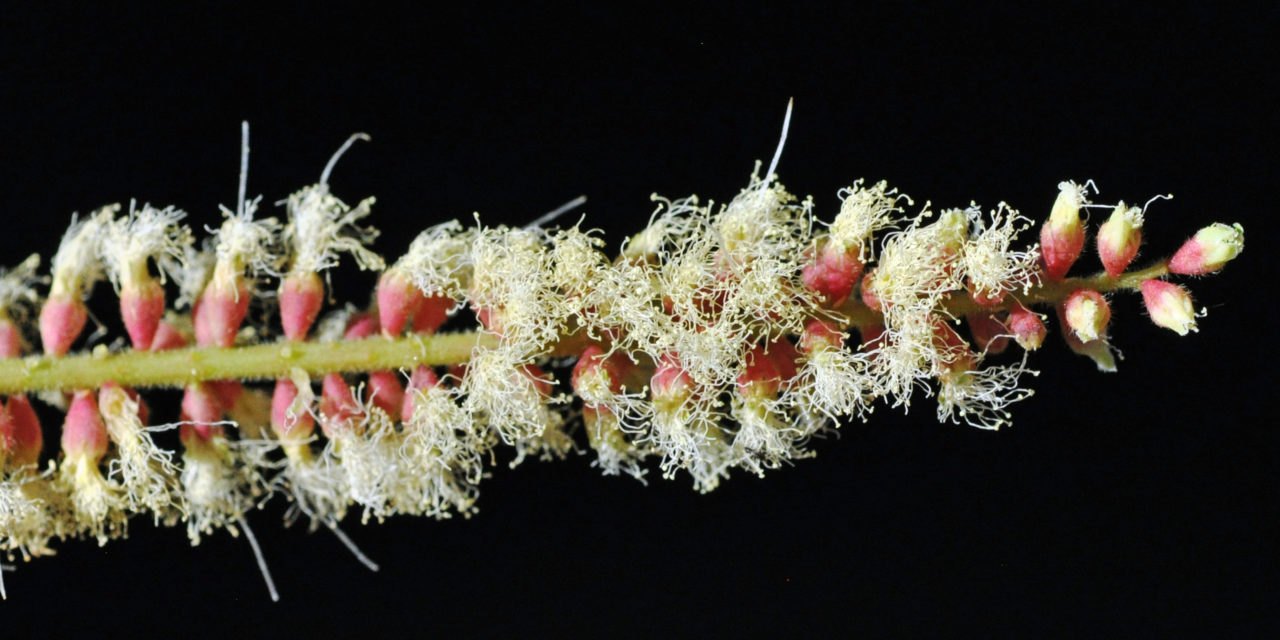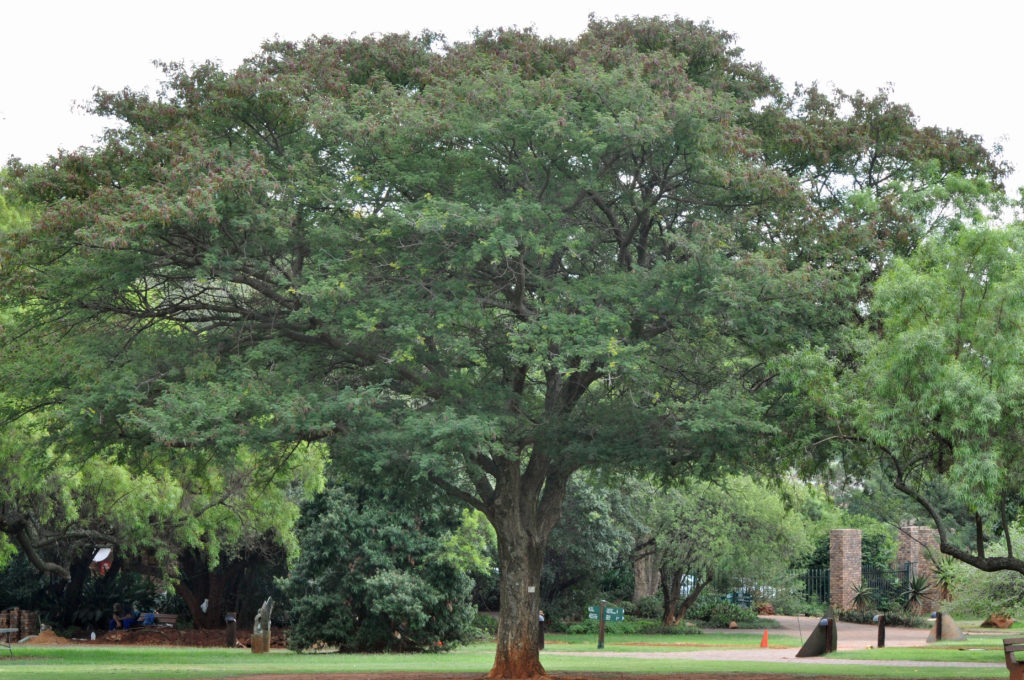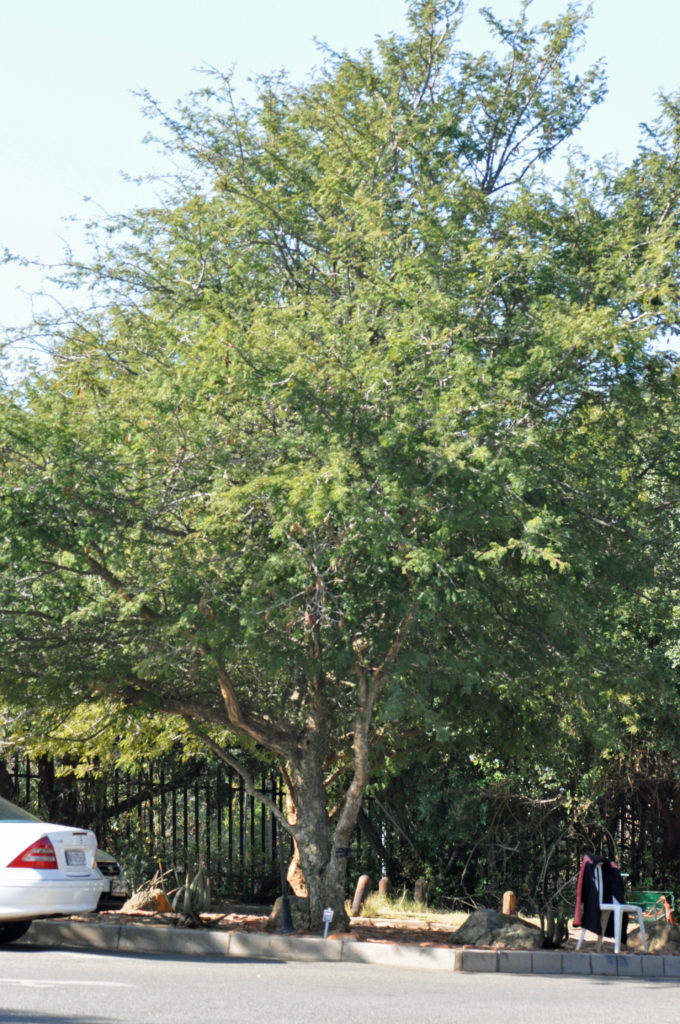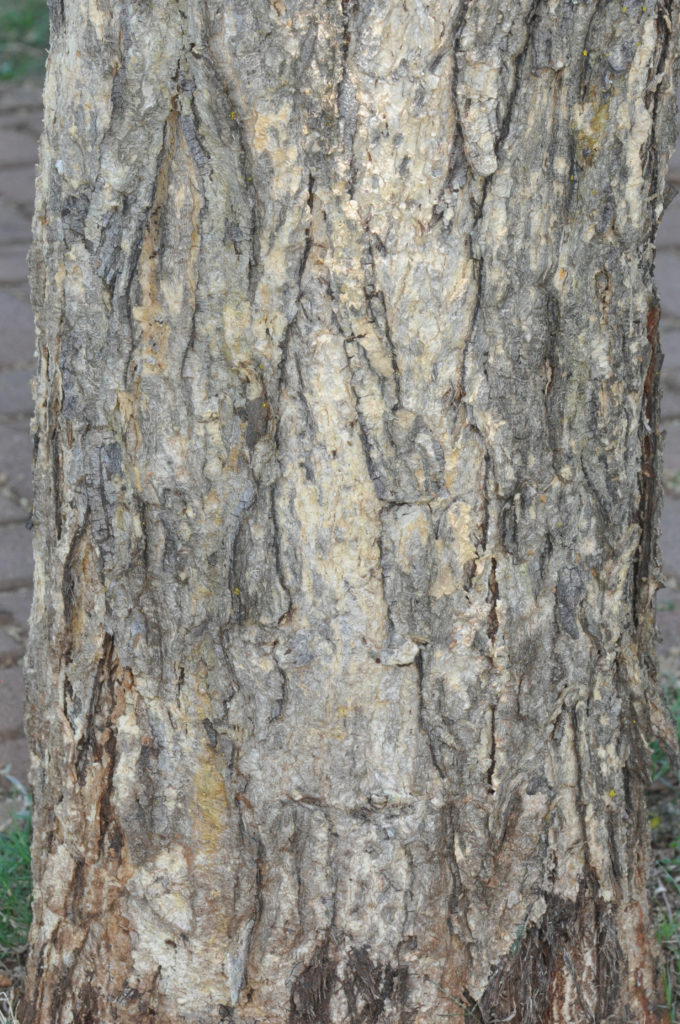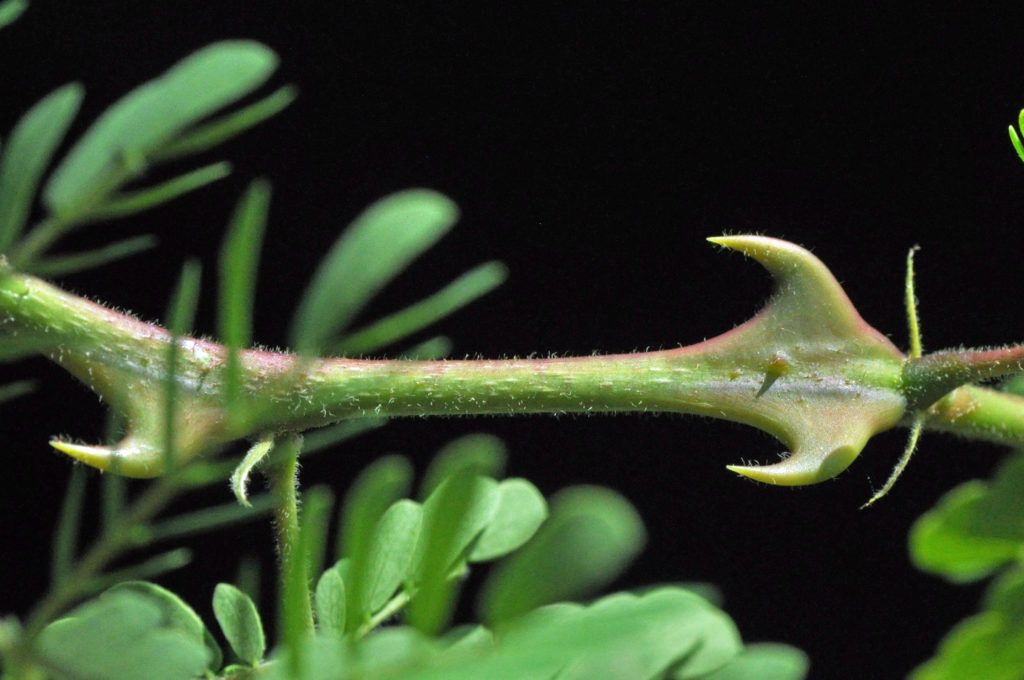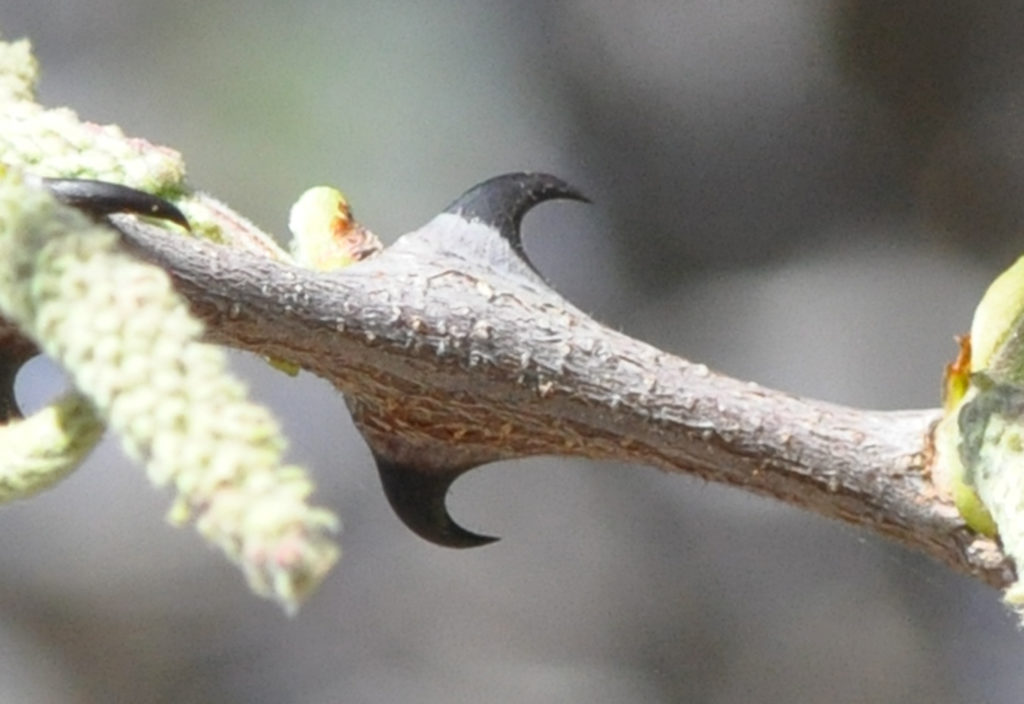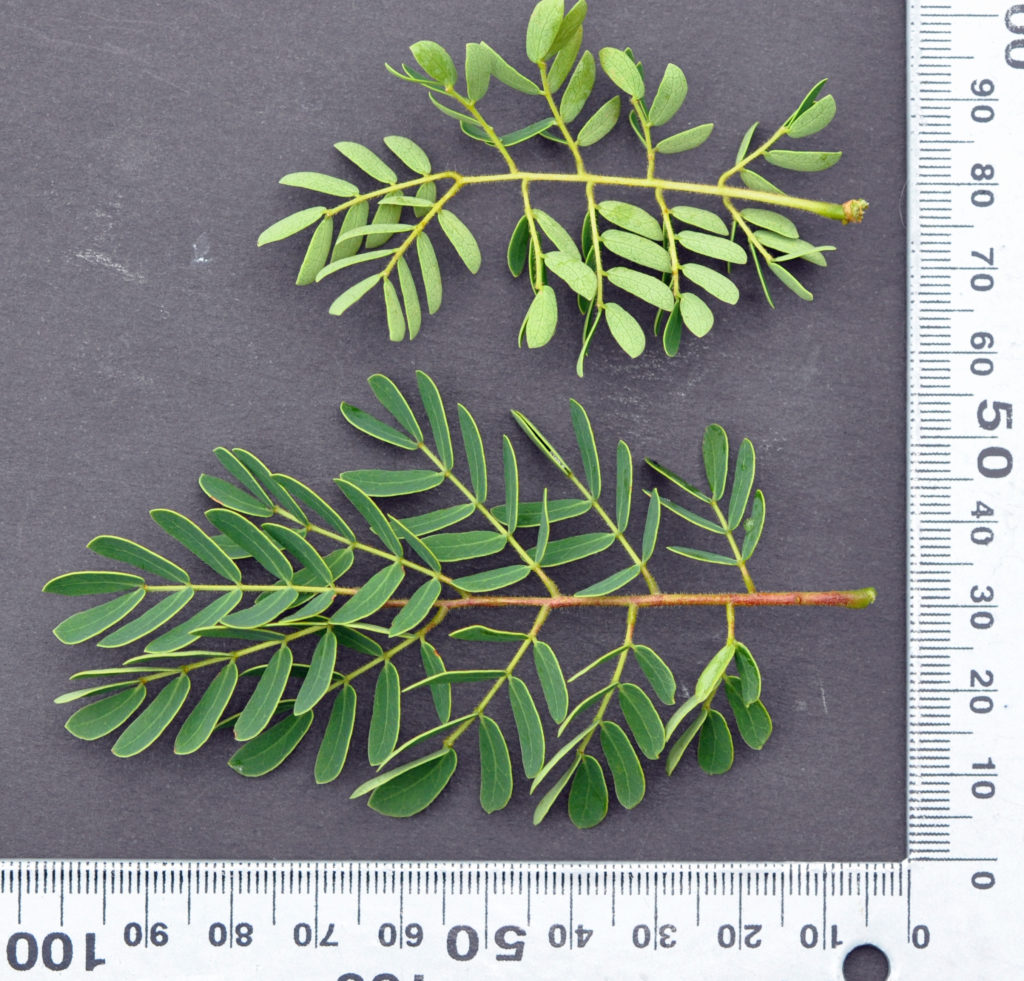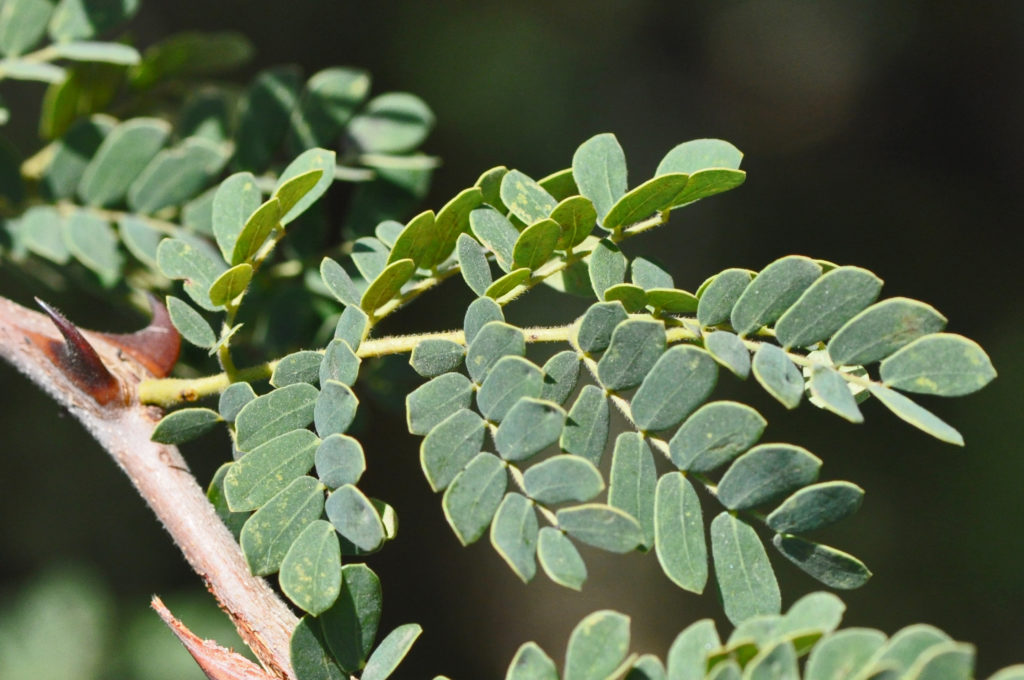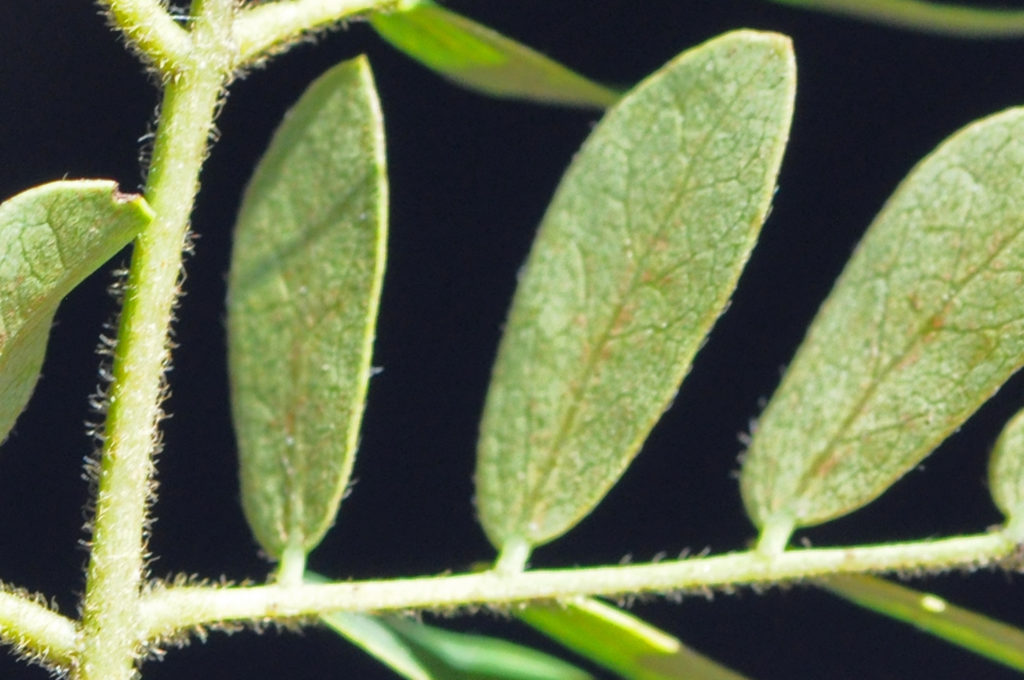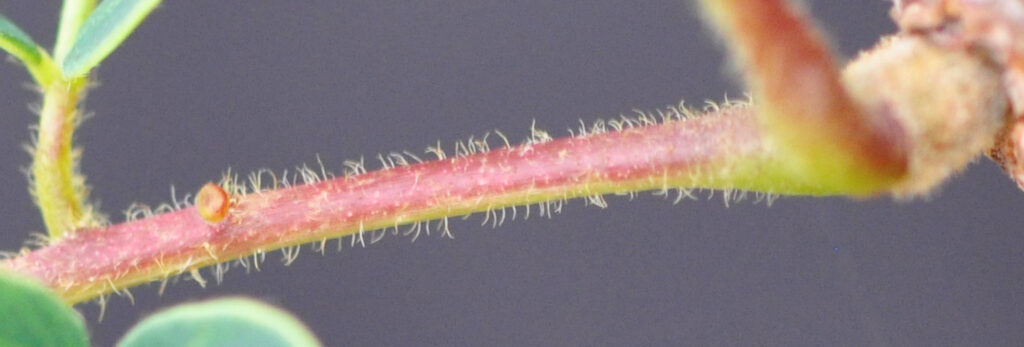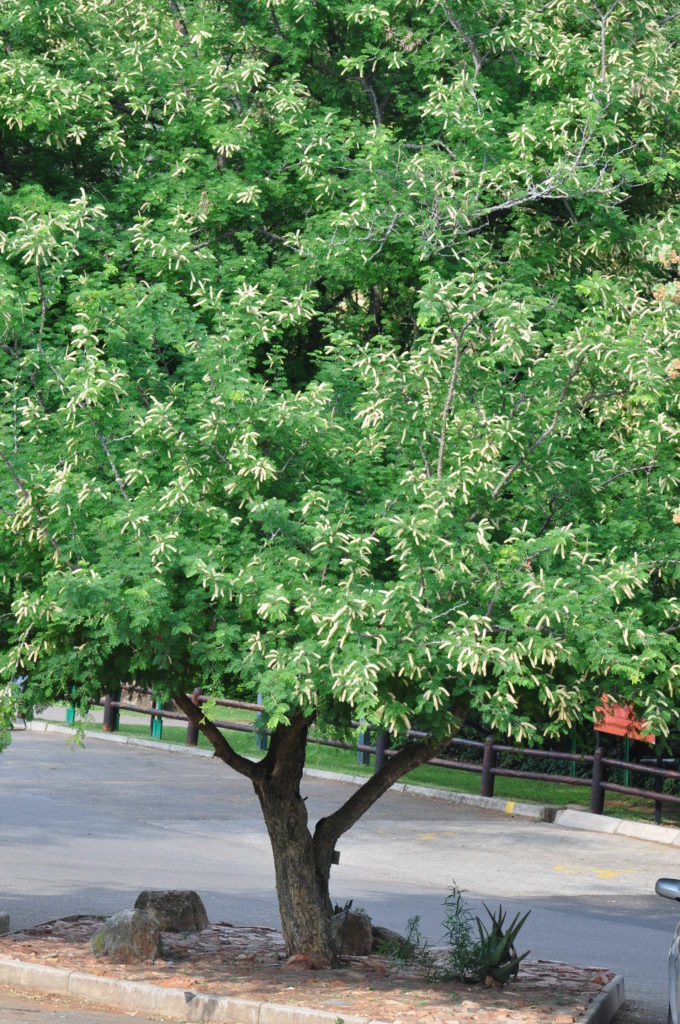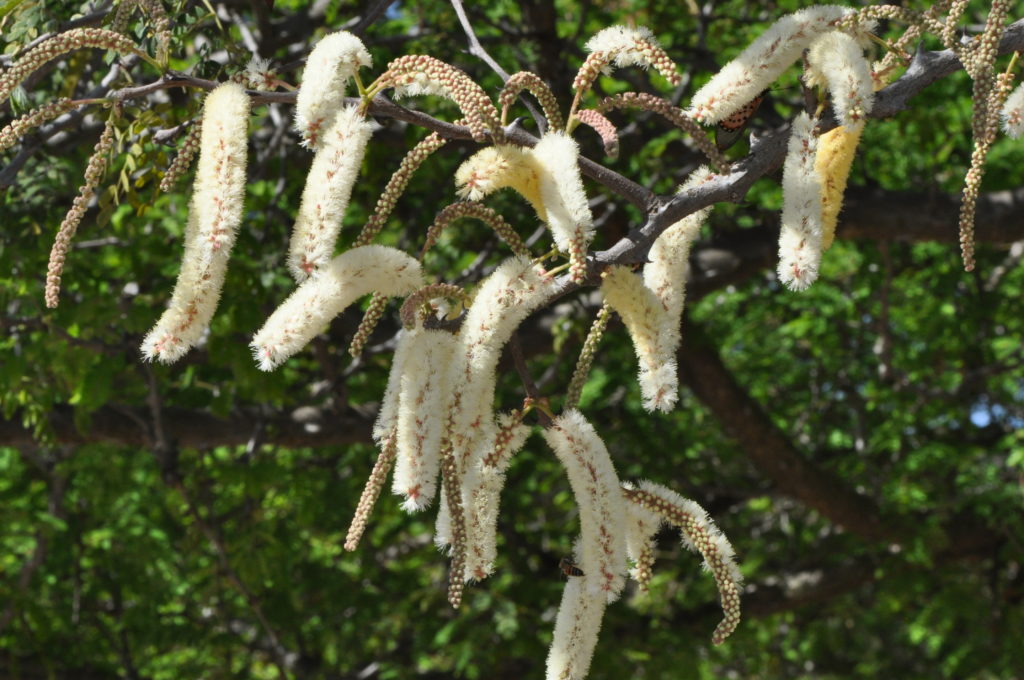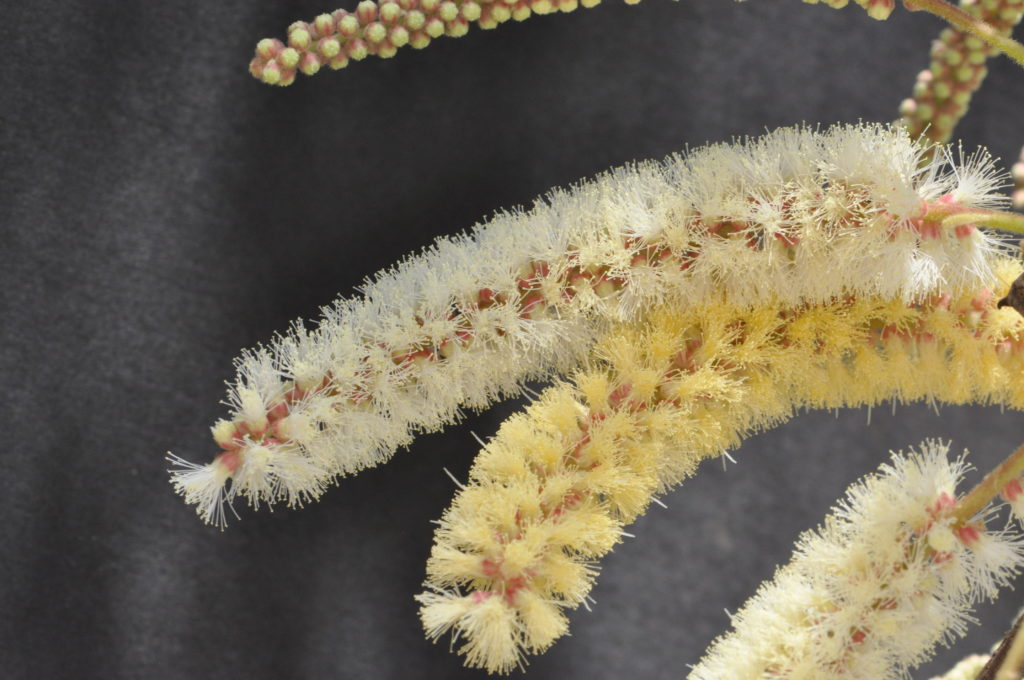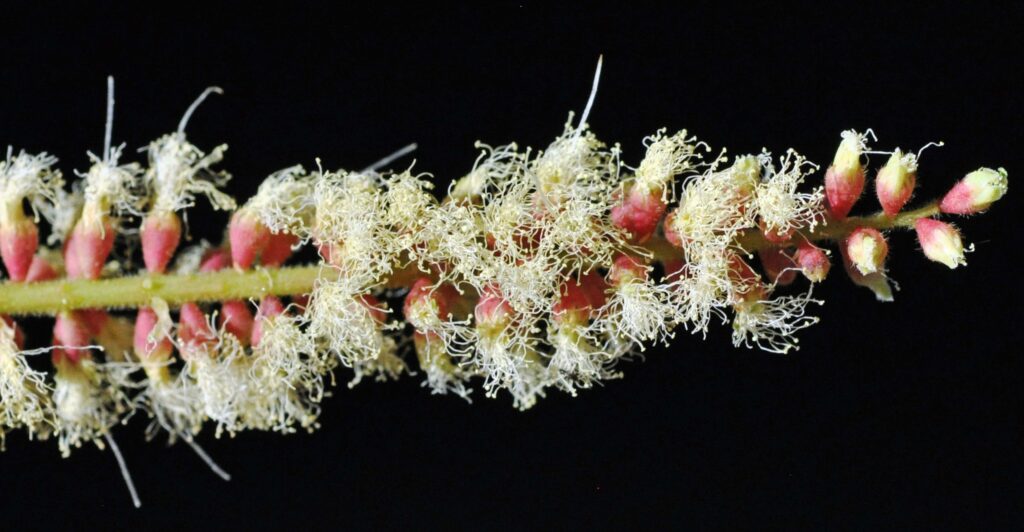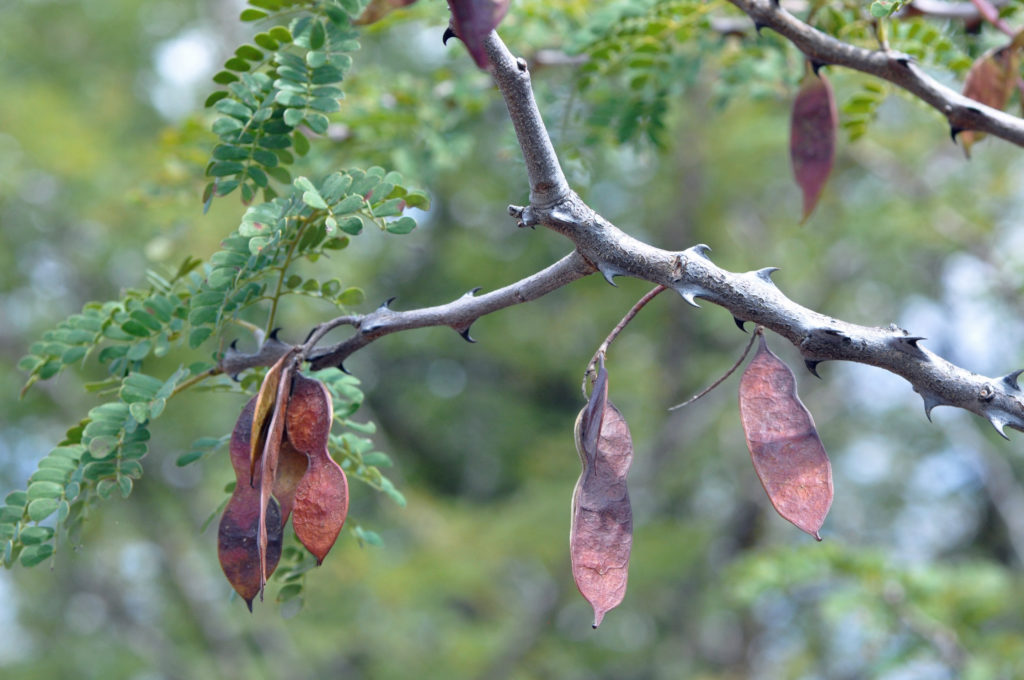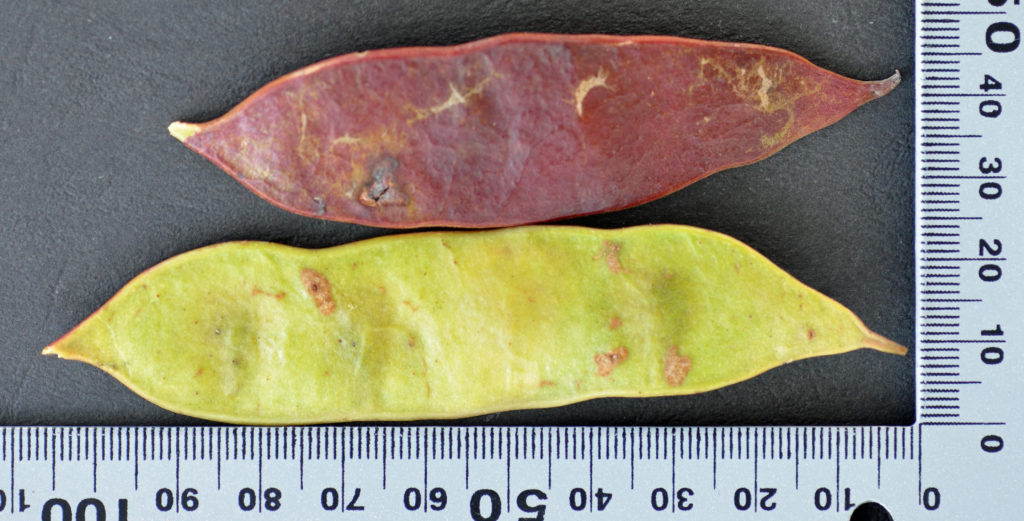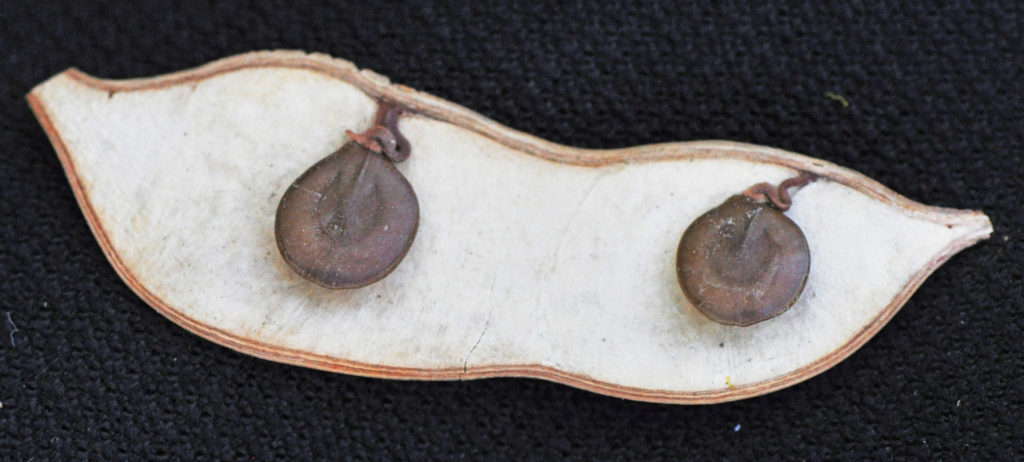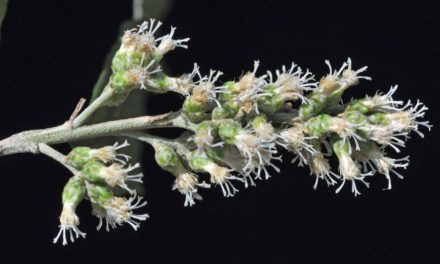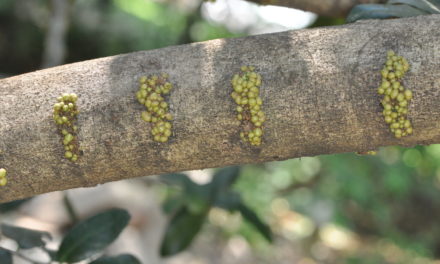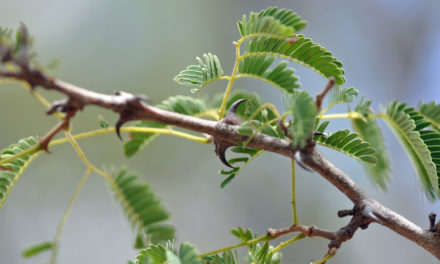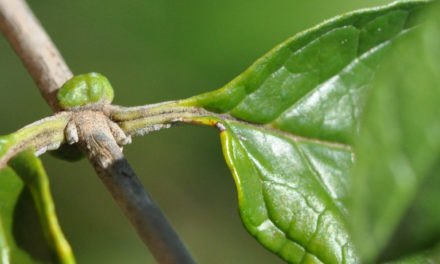General Info – summary
This Tree may reach 30m high. Branches have sharp, paired and hooked thorns. Bipinnate Leaves have non-spinescent stipules. Leaflets have entire margins and short petiolules. Small, creamy, regular bisexual Flowers are in spikes. They have a red calyx and many stamens. After pollen is shed, the style extends the receptive stigma beyond the anthers. Fruit is a straightish flattish pod, with compressed seeds.
Description
Senegalia burkei
Previous Names: Acacia burkei, Acacia ferox.
SA Tree No. 161.
Common names: (Afr) Apiesdoring, Basterknoppiesdoring, Bruin Apiesdoring, Haakdooring, Enkeldoring, Swart-apiesdoring, Swartapiesdoring. (Eng) Black Monkey Thorn. (isiZulu) Umbambampala, Umbabampala, Umkhaya, Umkhaya wehlalahlathi, Umunga, Wehlalahlathi. (Northern Sotho) Mokgwaripa, Mokwaripa, Mongangatau. (Setswana) Mokoba, Mokgwa, Mokotokoto. (siSwati) umKhaya. (Tshivenda) Munanga. (Xitsonga) Nkasinga.
Family: Fabaceae, or Leguminosae (Pea, bean or legume family). After the Orchidaceae and the Asteraceae, the Fabaceae is the third largest Angiosperm (flowering plants) family with 700+ genera and close to 20 000 species. Local Tree genera on this website include Acacia (Vauchellia, Senegalia), Albizia, Bauhinia, Bolusanthus, Burkea, Calpurnia, Colophospermum, Cordyla, Cyclopia, Dichrostachys, Erythrina, Erythrophleum, Faidherbia, Indigofera, Mundulea, Peltophorum, Philenoptera, Piliostigma, Schotia and Xanthocercis. The Fabaceae are recognisable by their fruit and by their pinnately compound Leaves. Leaves may also be simple – even bilobed and usually have stipules – some of which may be spinescent. Leaflets are usually entire. Flowers are bisexual and bracteate. Regular flowers usually have 4-5 sepals and the same number of petals. Irregular flowers have 4-5 sepals and 5 or less petals. Stamens have anthers that have 2 pollen sacs and there are usually at least twice the number of stamens as petals – often 10. The superior Ovary has 1 locule containing 1 or more ovules. The Stigma and Style are simple. The single carpel develops into the Fruit, which is usually a pod. The mature pods may dehisce or break into segments.
Name derivation. Species of the genus Vachellia and Senegalia were considered members of the genus Acacia until 2005. New Names. The genus Vachellia was named after George H. Vachell (1789 – 1839), chaplain and plant collector in China. Here the inflorescence is capitate (head like) and spinescent stipules are present. Plants in the genus Senegalia – (from Senegal) usually do not have spinescent stipules and the inflorescence is usually a spike.
Senegalia burkei. burkei named after botanist Joseph Burke (1812 – 1873). He collected the type specimen in Magaliesberg in the 1840’s. He arrived in Cape Town in January 1840. After numerous delays, he eventually crossed the Orange River in January of 1841. From here, he travelled to Kroonstad and on to Magaliesberg (collected birds, shot and collected skins of birds and mammals – including black rhino, zebra and waterbuck). He finally reached the Crocodile River near Hartbeespoort (Harties) where he also collected buffalo and a crocodile.
Conservation: National Status: L C. (Least Concern). Assessment: 2005 (W. Foden and L. Potter).
Tree
With its single trunk, this medium to large Tree (photo 359) is usually up to 12m but may reach 30m in height. The Bark is variable. It may be smooth, papery, and hairy and greyish (photo 592) or yellow in young branches, aging to brownish black. It may become rough or corky and may flake (photo 592). The mature tree usually has a flattened or rounded Crown (photo 359). Branching usually occurs away from the base, and lower branches tend to fall. The spread and height of the tree also seems to be partly dependent on the proximity of surrounding trees. Usually only the young branchlets are hairy (photo 43). In this photo, the hair-like non-spinescent Stipules (basal appendage of the petiole – leaf stalk) are visible. Just below the nodes are pairs of initially green, maturing to vicious black Thorns. Strongly hooked thorns may reach 9mm long and point towards the main stem (photo 47). These thorns have been likened to a parrot’s beak. Knobbly thorns may also develop on the trunk but are usually not numerous. Lenticels (usually raised corky oval or elongated area on the plant that allows the uncontrolled interchange of gases with the environment) are present on young branches (photos 43 & 47).
- 359. 2016/01/26. Pretoria NBG. Photo: D Becking.
- 274. 2014/06/24. Walter Sisulu NBG. Photo D Becking.
- 592. 2014/10/30. Pretoria NBG. Photo D Becking.
- 43(2). 2015/10/06. Walter Sisulu NBG. Photo: D Becking.
- 47. 2014/09/30. Walter Sisulu NBG. Photo: D Becking.
Leaves
The velvety Leaves are up to 9cm long. The possibly hairy Petiole (leaf stalk) is up to about 3,5cm long and is often sun induced reddish above (photo 397 & 399). A small, stalked gland often occurs about halfway up the petiole (photo 397). The thin Stipules (basal appendages of the petiole) are thread-like and do not become spinescent (photo 43 under Tree). Leaves are bipinnate (Compound: twice pinnate. The central axis or Rachis has lateral pinna “branches” not leaflets and the pinnules Leaflets – photo 399 are on these “side branches”. Leaves have 4-14 pairs of lateral Pinnae (sub-divisions) – each of which has up to 19 pairs of leaflets. Leaflet number, size and shape varies. They are usually slightly obovate (egg-shaped – with the narrower end at the base) to almost rounded. Leaflets may be bluish dull green above, lighter below (photo 399) and up to 2 x 1,3cm. The Margin is entire (with a continuous margin, not in any way indented) and may have a fringe of hairs (photo 76). The hairy leaflet Base is usually asymmetric. Petiolules (stalks of leaflets) are very short (photos 270 & 76).
- 399. 2014/12/09. Walter Sisulu NBG. Photo: D Becking.
- 270. 2014/06/24. Walter Sisulu NBG. Photo: D Becking.
- 76M. 2015/05/05 Walter Sisulu NBG. Photo: D Becking.
- 397. 14/12/09. Walter Sisulu NBG. Photo D Becking.
Flowers
Flowering occurs at branch ends with the mature leaves (photo 470). The very small Flowers are contained in a bottle brush-like initially white elongated Spikes (simple indeterminate inflorescences with sessile flowers on a single unbranched axis opening in succession towards the apex – photo 61R). The spikes are clustered. Each spike is up to 8,5cm long and rests on a single Peduncle (stalk of flower clusters – photo 182).
The bisexual flowers are actinomorphic (Regular, symmetrical. They are vertically divisible into similar halves by more than 1 plane passing through the axis). The hairy and distinctly pink to reddish Calyx lobes are up to 2,5mm long (photo 61R). The presence of hairs (photo 61R) help to distinguish this plant from Senegalia welwitschii (Acacia welwitschii). In Senegalia burkei the yellowish Corolla is up to 3mm long (photo 61R). However, it is the great number of protruding free and spreading white Stamens that provides the framework for the white or aging, creamy yellow colour of the flowers (spikes in photo 184). There is a single Pistil (a unit of the Gynoecium, the female element of the flower, composed of Ovary, Style and Stigma). The superior Ovary has a single locule. From the ovary the filiform (thread or filament like) Style eventually extends the single style with the terminal Stigma (the part of the pistil that receives the pollen) well beyond the rest of the now yellowing flower (photo 184, 61R). This extension occurs after the anthers have shed their pollen. At this stage, the stigma can receive pollen (photo 61R). This delaying process is clearly visible in photo 184 and helps to prevent self-pollination. (Sep–Jan).
- 470. 2014/06/24. Walter Sisulu NBG. Photo D Becking.
- 182. 2014/10/21. Walter Sisulu NBG. Photo: D Becking.
- 184 2014.10.21. Walter Sisulu NBG. Photo: David Becking.
- 61R. 2016/10/25. Pretoria NBG. Photo: D Becking. Dissected.
Fruit
The dehiscent Fruit is a more or less straight and flattish Pod (photo 272) up to 17 x 2,5cm. It changes from green to yellow to red and dark brown or purple when mature (photos 96 & 272). The pendulous and coriaceous (leathery) pod starts and ends in short, flexible points (photo 272). A pod may remain on tree for many months and may have slight constrictions between seeds (photo 96). Surface veins may be conspicuous. Circular compressed Seeds are up to 13 x 11mm (photo 819). Here the horseshoe-shaped markings on the seed are clearly visible, as is the Funiculus (the stalk by which the ovule/seed is attached to the ovary wall or placenta in photo 819). Parasites may damage the seeds. (Dec-July).
- 96. 2014/08/19. Walter Sisulu NBG. Photo D Becking.
- 272M. 2014/06/24. Walter Sisulu NBG. Photo: D Becking.
- 819. 2015/09/29. Walter Sisulu NBG. Photo: D Becking.
Distribution & Ecology
This frost tolerant plant grows in various soil types – in grasslands, forest fringes and in the bushveld (a sub-tropical mineral-rich woodland ecoregion of southern Africa occurring in Limpopo and Northwest in South Africa) up to an altitude of about 1 300m. The pant occurs naturally in KwaZulu-Natal – from the Tugela River northwards, including Swaziland, Mpumalanga, Gauteng, North-West, Limpopo, Zimbabwe, mainly southern Mozambique and Botswana. Giraffe, monkeys, antelope and elephants eat the Leaves and Pods. This plant supplies the larval food for the butterfly Deudorix penningtoni and Van Son’s playboy butterfly (Deudorix vansoni). In the second mentioned, the male butterfly is largely pink on the upper side and here stem galls serve as larval food. In Senegalia burkei both monkeys and bushbabies consume the Gum. Two forms of Senegalia burkei have been noted. A larger leafed form often has a rounded crown and grows on stony and loamy soils. The other form is flat-topped and thrives on sandy soils. However, there are a lot of overlapping forms.
Ethnobotany
The tough, dense and dark brown heart Wood is difficult to work. Uses include hut building, furniture, fuel and long-lasting fence posts. Research has shown that tree extracts have an antimicrobial effect. The edible Gum is a water-soluble sugary polysaccharide, exuded to seal wounds. It prevents infection by bacteria and fungi and helps prevent trees from freezing. This is a good garden tree, but grass does not grow well under the dense shade of a mature tree. Roots have an extractable yellow dye. Bonsai growers make use of this tree. Some believe this tree may attract lightning and that it should be avoided in a storm. However, this applies to most trees.
References
Boon, R. 2010. Pooley’s Trees of eastern South Africa. Flora and Fauna Publications Trust, Durban.
Burrows, J.E., Burrows, S.M., Lotter, M.C. & Schmidt, E. 2018. Trees and Shrubs Mozambique. Publishing Print Matters (Pty) Ltd. Noordhoek, Cape Town.
Coates Palgrave, M. 2002. Keith Coates Palgrave Trees of Southern Africa, edn 3. Struik, Cape Town.
Foden, W. & Potter, L. 2005. Senegalia burkei (Benth.) Kyal. & Boatwr. National Assessment: Red List of South African Plants version 2020.1. Accessed on 2024/02/13.
Lawrence, G. H. M, 1951. Taxonomy of Vascular Plants. The Macmillan Company, New York. Tenth Printing 1965.
Palmer, E. & Pitman, N. 1972. Trees of southern Africa. Balkema, Amsterdam, Cape Town.
Ross, J. H. A conspectus of the African Acacia Species. 1979. Botanical Research Institute.
Schmidt, S. Lotter, M. & McCleland, W. 2002. Trees and Shrubs of Mpumalanga and the Kruger National Park.
http://www.sana.co.za/pdf/Acacia-Species-Name-Change.pdf
http://www.zimbabweflora.co.zw/speciesdata/species.php?species_id=125810
http://waynesword.palomar.edu/plaug99.htm
https://en.wikipedia.org/wiki/Deudorix_penningtoni
http://posa.sanbi.org/flora/browse.php?src=SP

